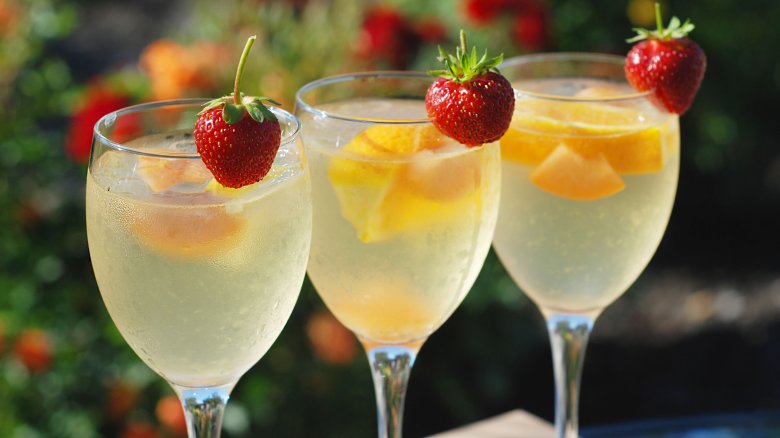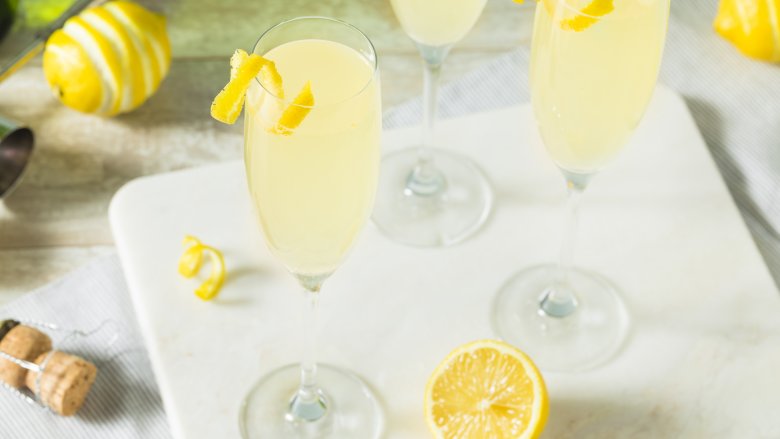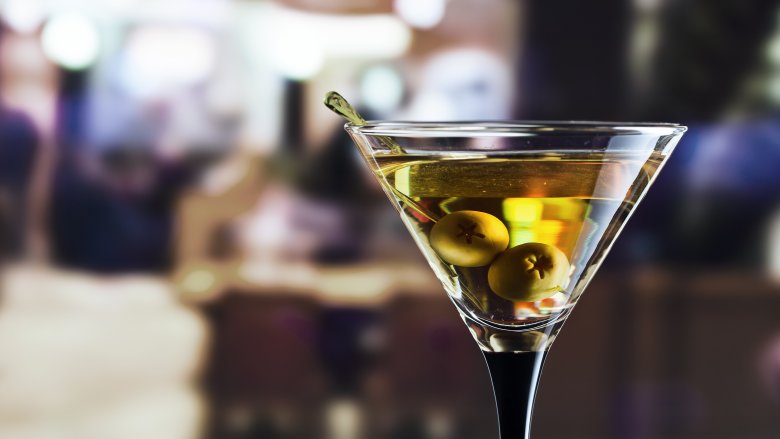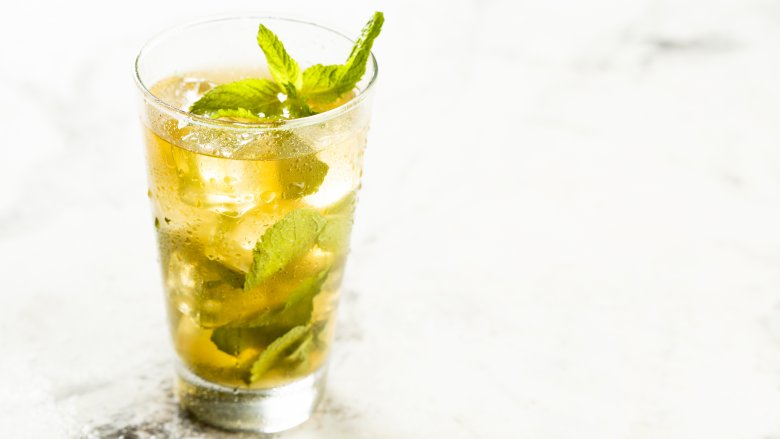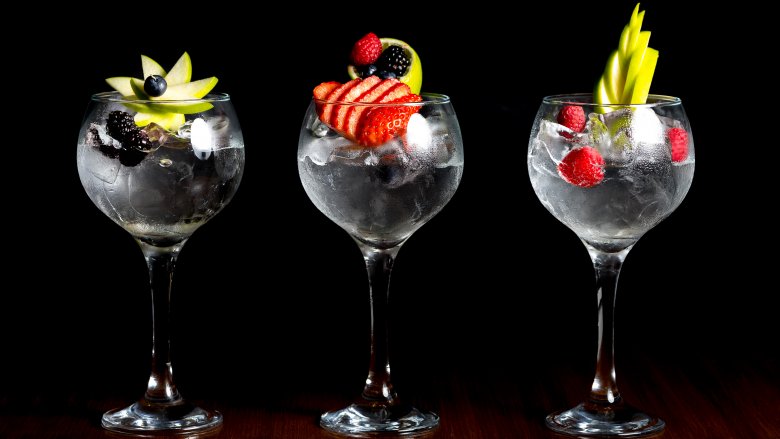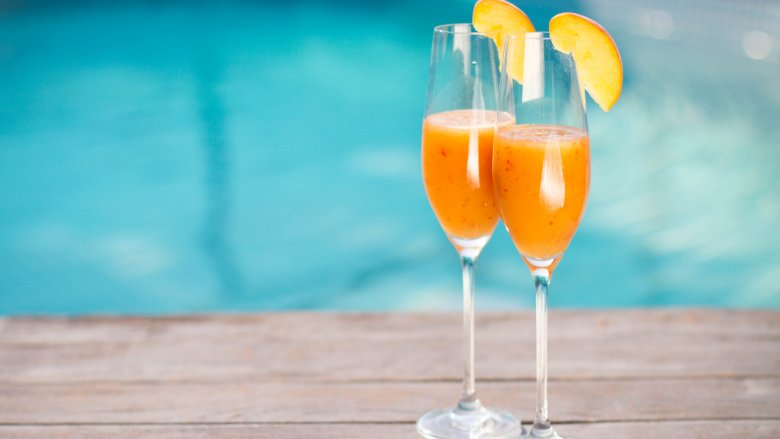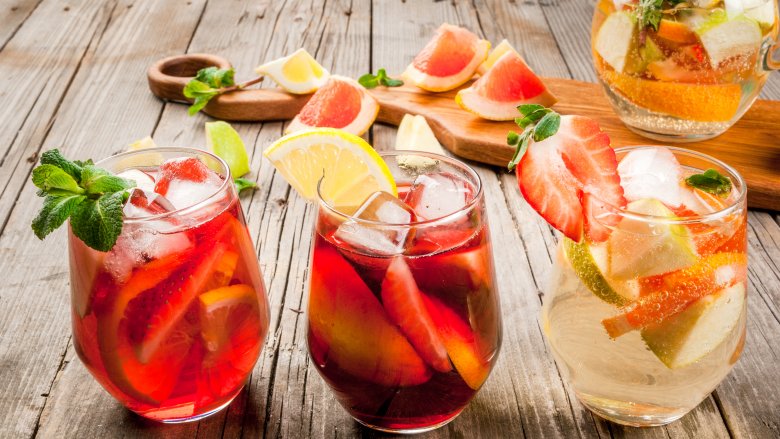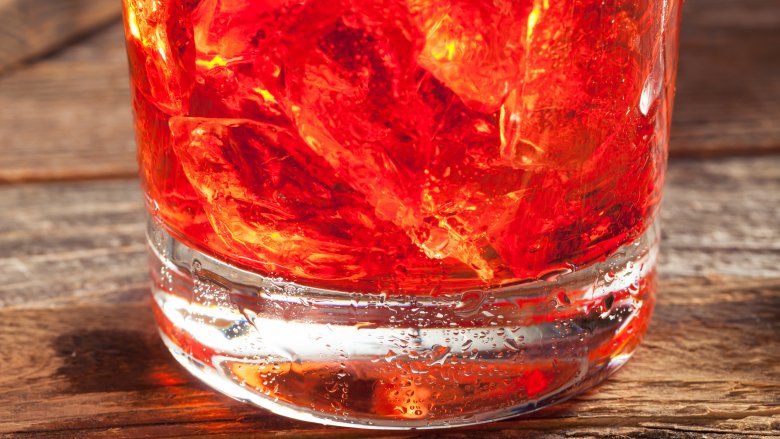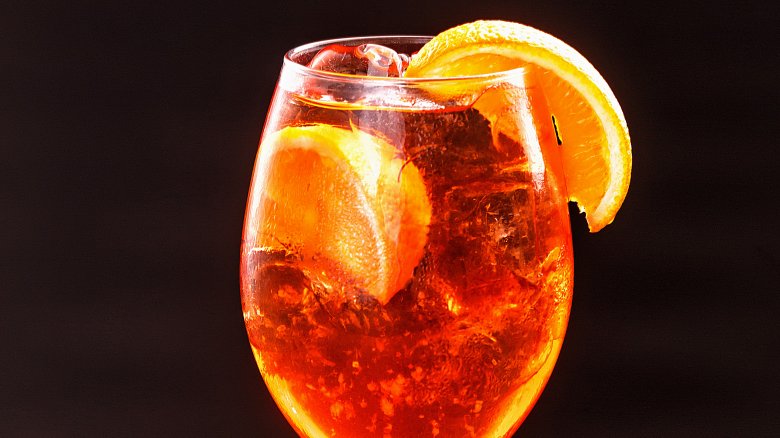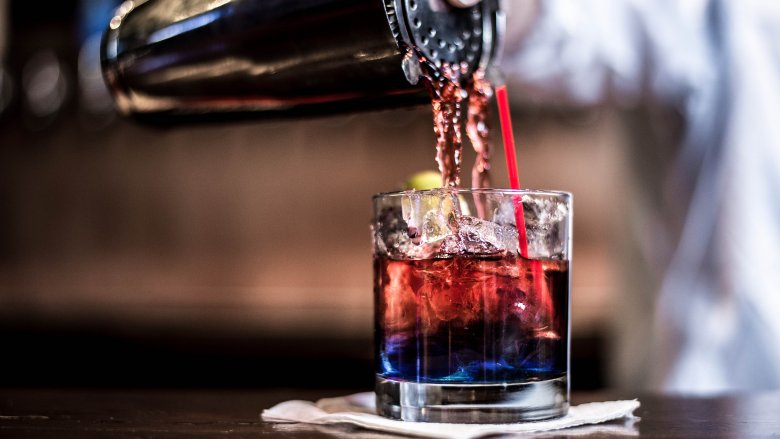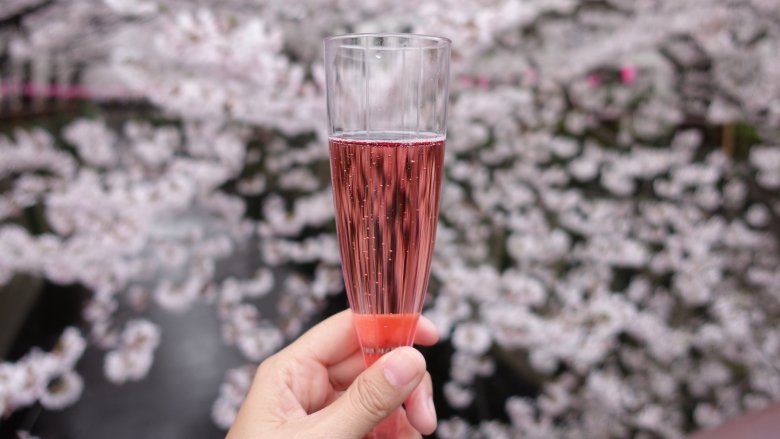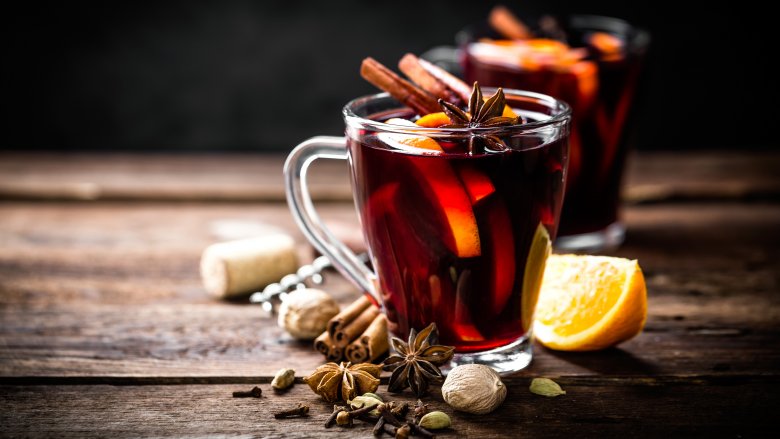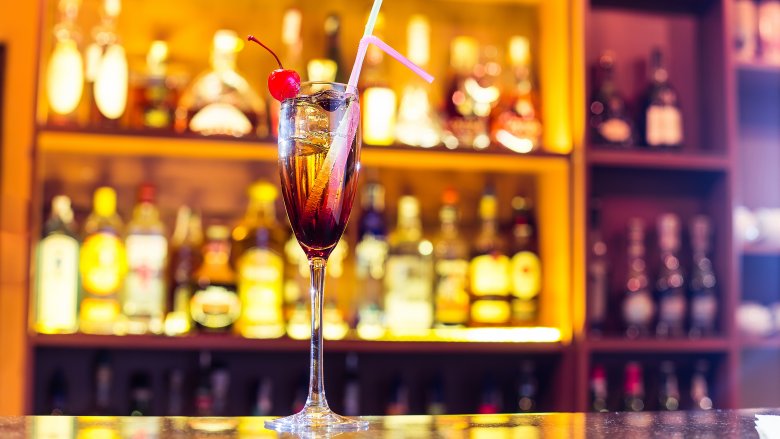Best Wine Cocktails You Should Be Making At Home
When you think of cocktails, you probably tend to think of something involving rum, vodka, or another kind of hard liquor. But there's no reason to stop there, because wine can be used to make some seriously brilliant cocktails.
It doesn't matter if you're stuck in the doldrums of long winter months, or if you're looking for something light, fresh, and fruity for a warm summer evening. It also doesn't matter if you prefer red or white, dry or sweet — there's something here for you. Best of all, there are so many different flavor profiles and types of wine that creating some of these cocktails is an exercise in experimentation. There's no right or wrong way for a lot of them, and you can definitely feel free to substitute when it comes to adding things like fresh fruit. Just pick whatever works with the flavor profile of your favorite wine!
There's a surprising amount of variety here, so let's talk about some cocktails that will have you drinking wine in ways you never knew were possible.
French 75
The basic idea of the French 75 goes back to sometime in the 19th century, says Gin Foundry, and if you're a fan of classic literature (or classic cocktails), there's a good reason for you to try this — it was a favorite of Charles Dickens, who used to serve it to all his guests. Prefer a classic movie to a classic book? It even got some screen time in Casablanca.
The name is from the Prohibition era, and it's thought to refer to the World War One 75mm Howitzer. A favorite weapon of both the French and the Americans, it had a mean kick — and the drink can, too.
It's super easy to make. Juste use a shot of your favorite gin, a dash of lemon juice and simple syrup to taste, then fill the rest of the glass with champagne. It's a bubbly, super-charged cocktail that's not too sweet, not too fruity, and strong while still being refreshing: it's the perfect end to a long day.
Sake martini
Wine has been a part of mankind's culture for centuries, and that's true for sake, too. Sakaya says it's been a part of Japanese and Chinese culture longer than a written language has been, and it's been an invaluable part of everything from religious ceremonies to everyday life. It's that last part we're tapping into with the sake martini, or saketini.
The basics for this one are simple: Grab a martini glass, and fill with 2.5 ounces of gin to half an ounce of sake. Stir, and garnish with a cocktail olive if you like. That's it! You can definitely mix this one up, too, and the possibilities are pretty endless. Switch out the gin for vodka, and while you're at it, what about some flavored vodkas? If you've ever wanted to try some of the more odd-sounding vodkas like cucumber, this is the perfect drink for it. You can also go for a citrus vibe with blood orange or grapefruit flavors, or how about trying ginger, lychee, mango, or apple?
Americano Spritz
The Americano Spritz is a light, refreshing, bubbly drink you're going to need something specific for: Cocchi Americano. This apertif has been around since the end of the 19th century, and it's basically a white moscato wine infused with a top-secret blend of spices and herbs. That's going to be your base for this one, and while you're out picking up a special bottle of Cocchi Americano, stop and get some fresh fruit, too.
Start with a shot and a half of Cocchi Americano, then add white grapefruit juice, a few slices of orange, a sprig of mint, and fill the glass the rest of the way with prosecco or champagne. Add more fruit to taste, and be sure to serve this one chilled and over ice. It's the perfect wine cocktail for sipping on the back porch after a hot summer afternoon, and don't worry — you're going to be able to make more than a few of these cocktails from that single bottle of Cocchi Americano.
White port and tonic
When you think cocktails with tonic, you think of gin. But Portugal has a different idea of what to mix with it — they use white port.
If you're not familiar with it, this is a must-try. White port tends to be on the dry side, which makes it a passable replacement for gin. It's got a few other things going for it — while it's just as light and refreshing, it's lower in alcohol content and you can pick up a bottle for much less than you'd spend on a good bottle of gin. Mix it up at about one part white port to two parts tonic, pour over ice, and technically, you're done. It's that simple, but it's definitely a drink that can also benefit from some embellishments. Swap out regular tonic for some flavors, and don't be afraid to get creative — this is the perfect drink to try out that elderflower tonic you've been eyeing. Add some citrus twists to garnish, serve cold, and enjoy the simplicity.
Bellini
According to Eataly, the very first Bellini was served in 1948, by bartender Giuseppe Cipriani of Venice's Harry's Bar. Cipriani created the Bellini to take full advantage of the seasonal produce of the surrounding countryside, and that means no matter what your tastes — and what's in season — there's a Bellini for you.
Cipriani's original Bellini is simple: one part fresh peach puree and two parts prosecco (but you could also substitute in champagne). Stir, chill, and serve! There are a ton of different ways to mix this one up, and a great one is to simply use whatever fresh fruit is in season. Puree some raspberries or strawberries, or for a version that's perfect for the hottest summer afternoons, use frozen fruit instead of fresh. Add some ice when blending up the puree, and make a frozen Bellini instead. This one's so versatile you can go in the complete opposite direction in the winter. Simmer some red wine, winter spices like cinnamon, clove, nutmeg, star anise, and vanilla until it turns to a syrup, then chill your mulled wine mix. Use that in lieu of fresh fruit, top with champagne, and you have a wintery, wonderful Bellini.
Sangria
There are so, so many different versions of sangria it's impossible to talk about them all, so let's start with a traditional one. At heart, sangria is simple enough: a young red wine, oranges, lemon, and cinnamon. Mix, chill, and done!
There's no real right or wrong way to make this fruity, wine-based cocktail, and there's no real limit to what you can add and still call it sangria. Throw in some other fruits, like peaches, apricots, limes, grapefruit, and even apples or blueberries. You don't even have to use red wine! Mix it up with white wine, peaches, and apples, or use a base of red wine and brandy. Use rose wine, sweeten it even more with some strawberries, raspberries, and blackberries, then add some citrus for a bit of extra pucker. With so many flavor profiles in wine, this is one cocktail you can mix, match, and experiment with. You might even create your own go-to, personalized version that will become your signature cocktail of summertime parties and barbecues.
Neal Bodenheimer's Campari-Fennel Apertif
Looking for something simple, elegant, and as pretty as it is tasty? Try Neal Bodenheimer's recipe for a Campari-Fennel Apertif.
Fennel, you're saying? Absolutely! Bodenheimer — owner of Cure in New Orleans — says there's something magical that happens when you add fennel, half a shot of Campari liqueur, half an ounce of simple syrup, lemon, and a few ounces of your favorite dry, sparkling wine. In order to get the full flavor, he says it's key to muddle the ingredients before adding ice, shaking, straining, and pouring into a rocks glass and over a few more ice cubes. Add another spring of fennel to garnish, and this isn't just a great cocktail that can stand alone, it's also a great way to dress up that glass of wine you want to serve with your favorite Italian dish. Looking for something with just one extra step for a special occasion? This might be your new go-to.
The Queen's Dubonnet cocktail
There are a lot of benefits to being royalty, but one of the best perks might be the ability to day drink and not have anyone judge you. According to The Telegraph, Her Majesty drinks around six units of alcohol a day, and even though that's an amount that actually pushes her into the same category as any college binge drinker, she does it with class. They say that every day, just before lunchtime, she sips her favorite wine-based cocktail: a Dubonnet.
Best of all, it's an easy one to make. It's two parts Dubonnet, a fortified wine aperitif, and one part gin. That's it! The herbs of the Dubonnet are pretty much the perfect compliment to the rustic notes of the gin, and the only thing this cocktail might benefit from is a twist of lemon or orange to garnish. Serve over a glass full of ice, and it's the perfect cold cocktail to make you feel like royalty... no matter what time of day it is.
MacArthur Punch
Even if you're not up on your World War II-era military history, you're probably familiar with the name General Douglas MacArthur. He's the general who shaped the war on the Pacific front, and was the figure Allies rallied to after Pearl Harbor. He was such a popular figure that it's not entirely surprising that among the cocktails created during and after World War II, there was one named for him.
The MacArthur Punch is appropriately named, and if you're looking for something that packs a punch, this is the drink for you. It's an ounce each of Cherry Heering, dry orange Curacao, lime juice, sparkling water, and your favorite dry red wine. Add two ounces of orange juice and as much whiskey as you can handle, shake in a cocktail shaker, and you've got your MacArthur Punch. It's definitely not a cocktail to mess around with, and you're not going to be mixing it up — or serving it — like a traditional punch. It's the more military "punch" we're talking about here, and that's what makes this one a win!
Cherry Blossom
Cherry trees blossom in the springtime, and it's the same time everyone's glad to see the long, dark, winter months fading into a distant memory. The feeling you get when you see those pink blossoms taking over those long-bare branches is the feeling you'll capture in these incredible wine cocktails, appropriately made with sake.
There are a handful of ingredients to this one, but it's still super easy. Mix up one part grenadine, one part orange liqueur, two parts gin, four parts cherry liqueur, and sake to taste. Add a dash of lemon juice and a cherry, mix, and serve.
Alternately, you can swap out some of the ingredients for a dash of tart cherry juice, cranberry juice, or a splash of lime, and just what combination you add can depend on the flavor profile of the sake you choose. A Cherry Blossom should be light, fresh, with a hint of fruit — like the springtime staple it's known for.
Port of Call
The Port of Call is, of course, a port-based cocktail from the menu of the Clover Club. It's the brainchild of bartender Tom Macy, and it's one of his long-standing favorites. While there's a lot of wine cocktails you can experiment with, this one has a few ingredients that are absolutely necessary.
The first is an odd one: cranberry preserves. Don't doubt! Add a tablespoon to half an ounce of cinnamon syrup, three-quarters of an ounce of lemon juice, and an ounce each of ruby port and gin. Shake, strain into a glass over ice, and garnish if you like. Or not!
The cranberries make this one a great, festive sort of cocktail, and it's one that's easy to turn from those measurements — which will give you a single serving — into enough to fill a punch bowl. It's a great way to make any holiday a little extra special (without serving up something that's too boozy).
The Bishop and the Smoking Bishop
Both the Bishop and the Smoking Bishop are wine cocktails that date back to Victorian era Europe, and historian Elizabeth Gabay says (via NPR) they were part of a trend of drinks called ecclesiastics, and they were particularly popular through winter holidays.
So, what are they and how do you make them? The Smoking Bishop is definitely more complicated, and it's a sort of mulled wine. Start by roasting some whole oranges studded with cloves, until they're just turning brown. Then, add them to a pot with a bottle of ruby port, a bottle of red wine, a cup of water, half a cup of brown sugar, and spices to taste. Think Christmas, so that's things like allspice, nutmeg, and ginger. Simmer until everything dissolves, slice your oranges and squeeze in the juice, and serve it up.
The Bishop is easier — and it's cold. Mix up some red wine and rum in a ratio of 1:3 (or switch it up to taste), add a dash of simple syrup, and some lime juice. Alternately, you can swap out the lime for lemon or orange juice, and add as much or as little of the syrup as you like.
Kir (and the rest of it's family of cocktails)
The Kir is one drink that started an entire family of wine cocktails — and you should have them all on your must-try list. The most basic of these is the Kir, and it's simply a white wine with a dash of creme de cassis, or blackcurrant liqueur. It has a history that's as cool as it is simple — according to The Wall Street Journal, it's generally attributed to a Felix Kir, a mayor, priest, and World War II resistance fighter. The story goes that when the Nazis invaded France and seized all of the Burgundy region's finest red wines, Kir created the cocktail to not just keep his countrymen's spirits up, but to thumb his nose at the Nazis a bit, too.
Since then, there's been a couple of other versions added to the Kir family. The Kir Royale calls for the creme de cassis to be added to a dry champagne instead of white wine, and the Kir Blush replaces the white with a rose wine. The Kir Imperial switches up cocktail the other way, and uses a raspberry liqueur in place of the blackcurrant.
If the idea of mixing a liqueur with wine sounds too sweet for your tastes, try it anyway with a dry wine and just the smallest dash of liqueur.
